
The Dytiscidae – based on the Greek dytikos (δυτικός), "able to dive" – are the predaceous diving beetles, a family of water beetles. They occur in virtually any freshwater habitat around the world, but a few species live among leaf litter. The adults of most are between 1 and 2.5 cm (0.4–1.0 in) long, though much variation is seen between species. The European Dytiscus latissimus and Brazilian Megadytes ducalis are the largest, reaching up to 4.5 cm (1.8 in) and 4.75 cm (1.9 in) respectively. In contrast, the smallest is likely the Australian Limbodessus atypicali of subterranean waters, which only is about 0.9 mm (0.035 in) long. Most are dark brown, blackish, or dark olive in color with golden highlights in some subfamilies. The larvae are commonly known as water tigers due to their voracious appetite. They have short, but sharp mandibles and immediately upon biting, they deliver digestive enzymes into prey to suck their liquefied remains. The family includes more than 4,000 described species in numerous genera.
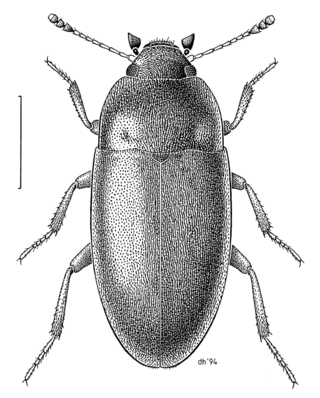
The family Archeocrypticidae is a small group of beetles with no vernacular common name, though recent authors have coined the name cryptic fungus beetles. Adults and larvae seems to be saprophagous and are often found in plant litter. Worldwide, about 10 genera and 50 species are found, most species are pantropical. Enneboeus caseyi has been recorded from the American South, Central America, and Mexico. About 20 species are found in Australia, in the genera Enneboeus,Australenneboeus and Gondwanenneboeus,Archeocrypticus,Falsoplatydema, Nothenneboeus, Sivacrypticus and Wattianus. They are largely absent from the Palearctic and Nearctic regions.

Megadytes is a genus of diving beetles in the family Dytiscidae. They are found in slow-moving or static freshwater habitats throughout most of the Neotropics, ranging from Florida and Mexico, through the West Indies and Central America, to South America as far south as central Argentina. The adult beetles measure about 1.65–4.75 cm (0.6–1.9 in) long depending on the exact species and the largest is also the largest in the family.
Austrodytes is a genus of beetles in the family Dytiscidae found only in northern Australia. The genus contains these two species:

Limbodessus is a genus of beetles in the family Dytiscidae, first described by Félix Guignot in 1939. It contains the following species:
Paroster is a genus of beetles in the family Dytiscidae, containing the following species:
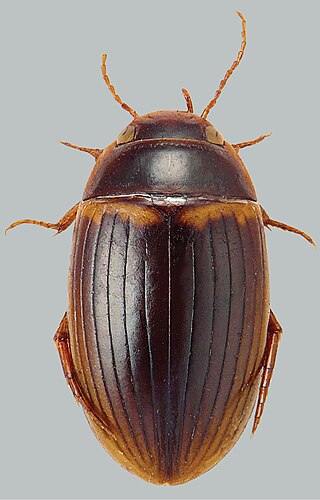
Copelatus portior is a species of diving beetle. It is part of the genus Copelatus in the subfamily Copelatinae of the family Dytiscidae. It was described by Félix Guignot in 1956.
Carabdytes plantaris is a naturally uncommon species of diving beetle in the family Dytiscidae. It is endemic to New Zealand. For over a century, it was known from just a single specimen collected in 1880 "near Dunedin", and doubts were cast on whether it was actually a New Zealand species at all. In 1986, it was rediscovered when several were collected from a roadside pond near Lake Ellesmere. Carabdytes plantaris is now classed as "naturally uncommon" by the Department of Conservation.
Brancuporus is a genus of predaceous diving beetles in the family Dytiscidae. There are at least two described species in Brancuporus. They are found in Australasia.

Neobidessodes is a genus of predaceous diving beetles in the family Dytiscidae. There are about 10 described species in Neobidessodes. They are found in Australasia. The genus was first described in 2009, and the type species is N. denticulatus.
Hydrovatus lyratus, is a species of predaceous diving beetle widespread in South Asia, South East Asia and Australian region.
Limbodessus leysi is a carnivorous subterranean water beetle, in the Bidessini tribe of the Dytiscidae family. It was first described in 2006, and the species epithet honours the entomologist, Remko Leys.
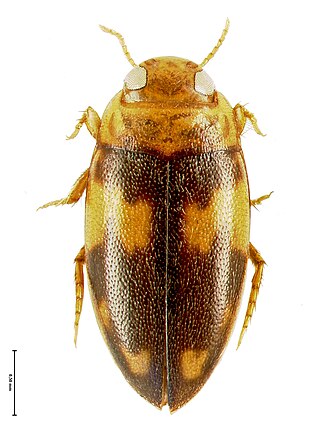
Neobidessodes flavosignatus is a carnivorous subterranean water beetle, in the Bidessini tribe of the Dytiscidae family. It was first described in 1922 by Albrecht Zimmermann as Bidessus flavosignatus. It was assigned to the genus Bidessodes by Watts in 1978, and to the new genus of Neobidessodes in 2009 by Hendrich and others.
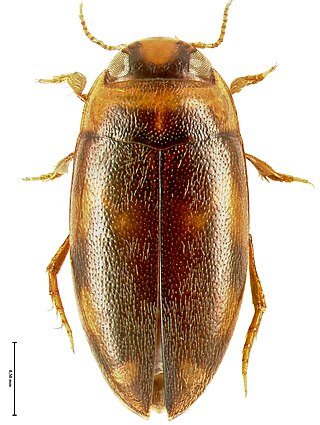
Neobidessodes mjobergi is a carnivorous subterranean water beetle, in the Bidessini tribe of the Dytiscidae family. It was first described in 1922 by Albrecht Zimmermann as Bidessus mjobergi, and reassigned to the genus of Neobidessodes in 2009 by Hendrich and others.
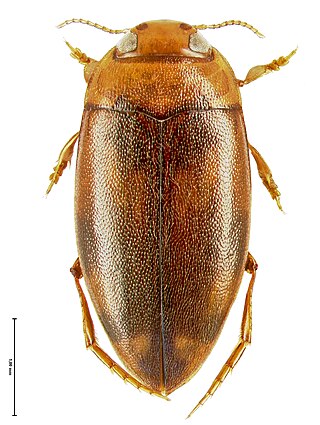
Neobidessodes grossus is a carnivorous subterranean water beetle, in the Bidessini tribe of the Dytiscidae family. It was first described in 1922 by Albrecht Zimmermann as Bidessus grossus. It was assigned to the genus Bidessodes by Watts in 1978, and to the new genus of Neobidessodes in 2009 by Hendrich and others.
Neobidessodes bilita is a carnivorous subterranean water beetle, in the Bidessini tribe of the Dytiscidae family. It was first described in 1978 by Chris H.S. Watts as Bidessodes bilita, and reassigned to the genus of Neobidessodes in 2009 by Hendrich and others.
Paroster caecus is blind beetle in the Hydroporini tribe of the subfamily Hydroporinae in the Dytiscidae family. It was first described by Chris Watts in 1982 as Terradessus caecus. It was transferred to the genus, Paroster, in 2016 by Toussaint, Hendrich and others.
Paroster arachnoides is water beetle in the Hydroporini tribe of the subfamily Hydroporinae in the Dytiscidae family. It was first described by Chris Watts and William Humphreys in 2004 as Nirripirti arachnoides. It was transferred to the genus, Paroster, in 2008 by Remko Leijs and Chris Watts.
Paroster bulbus is water beetle in the Hydroporini tribe of the subfamily Hydroporinae in the Dytiscidae family. It was first described by Chris Watts and William Humphreys in 2004 as Nirripirti bulbus. It was transferred to the genus, Paroster, in 2008 by Remko Leijs and Chris Watts.
Batrachomatus nannup is a species of diving beetle in the family, Dytiscidae, first described as Allomatus nannup in 1978 by Chris H.S. Watts. The holotype was collected in Bridgetown, Western Australia. In a generic revision in 2013, Lars Hendrich and Michael Balke synonymised AllomatusMouchamps, 1964 with Batrachomatus Clark, 1863, thus changing the species name.








